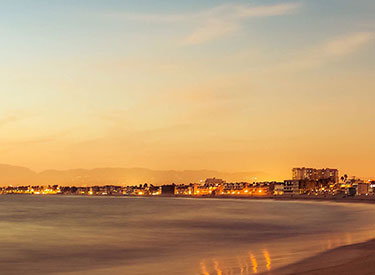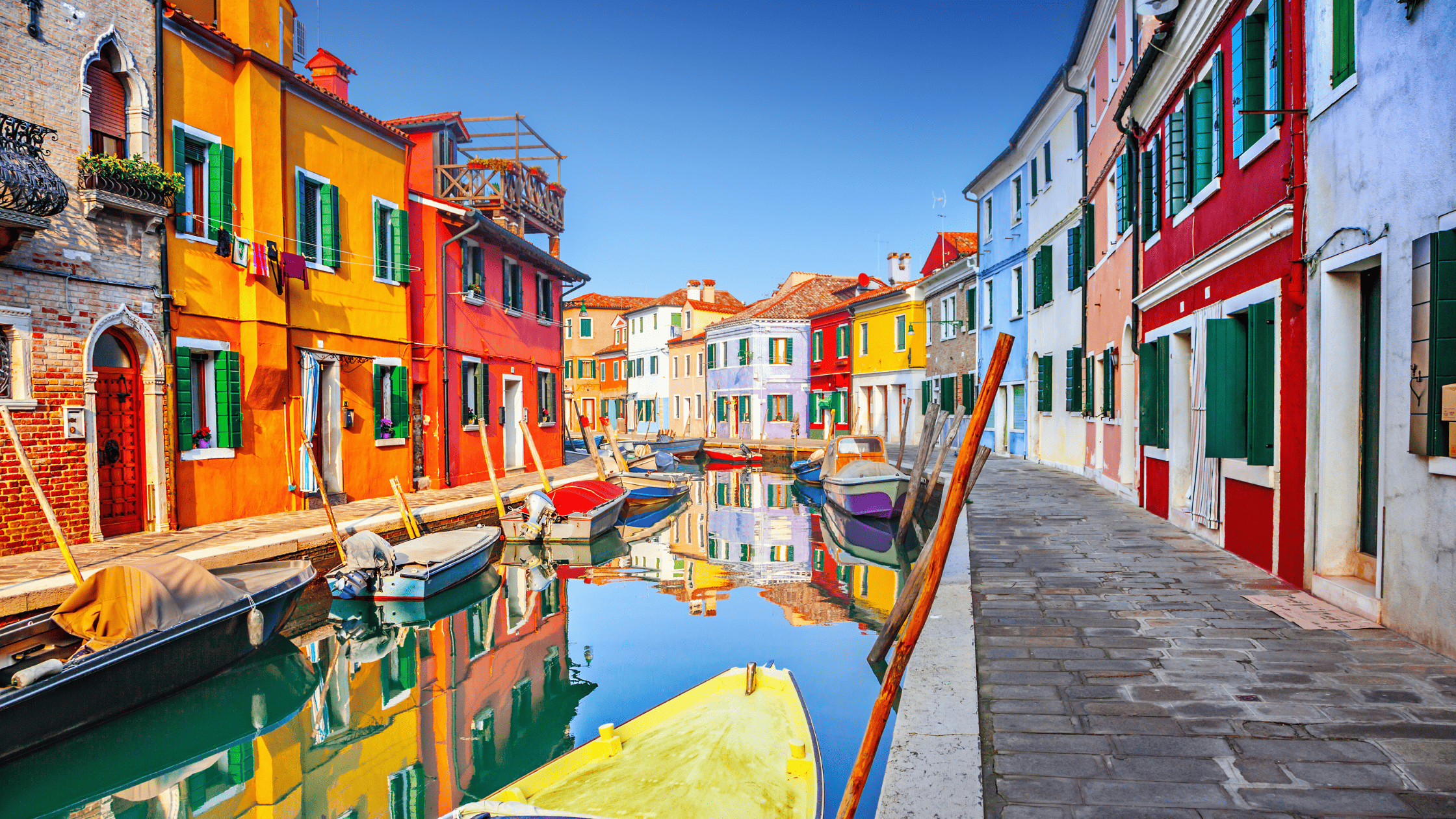


The world’s most colourful places are an eye-catching showcase of human creativity and natural wonder. From Latin America to the Mediterranean, from remote mountainsides to tropical islands, our pick-and-mix selection of multi-hued destinations is designed to add a big splash of colour to your next holiday:

Burano, Italy
From St Mark’s Square in Venice, it’s a 45-minute journey by vaporetto (the Venetian version of a water taxi) to the tiny island of Burano, which is renowned for its lace-making artisans and small, brightly painted houses. Narrow streets lure you into exploring on foot, finding your way along picturesque canals before emerging into charming squares lined with boutiques, bars and cafés.
Although increasingly popular as a tourist destination, Burano has retained its laid-back, welcoming atmosphere, making you feel that you’ve stepped back in time. Lace-making is still an important tradition on the island, and you can watch experts at work before choosing a beautiful hand-made piece to take home as a souvenir. The island’s other important industry, fishing, is on daily display in its excellent restaurants, and dishes like risotto al nero di seppia (squid ink risotto) and sarde in saor (marinated sardines) are unmissable local specialties.

Cinque Terre, Italy
This section of the Italian Riviera is famous for its five villages, each with its own distinct character and charm. Colourful houses, painted in shades of lemon, rose, peach and red, are interspersed with winding alleys, charming piazzas and terraced vineyards which cascade down steep slopes to meet the deep blue waters of the Mediterranean sea.
Travel by road is not really an option in this rugged landscape, although there is a local train service that connects the five villages. Our favourite way to explore Monterosso al Mare, Vernazza, Corniglia, Manarola, and Riomaggiore is to walk the impossibly scenic, twelve-kilometre hiking trail known as the Sentiero Azzurro (Blue Trail).
The National Palace of Pena perches high on a hilltop above the town of Sintra, looking like it was plucked straight from the pages of a fairy tale. It was constructed during the nineteenth century at the request of the Portuguese king, Ferdinand II, on the site of a much older monastery ruin, and was converted to a national museum in 1910.
Its exterior walls are painted in a rainbow of yellow, pink, salmon, with some sections of the facade tiled in vibrant blue Portuguse tile. The palace’s location, a short distance from Lisbon on the Atlantic coast, means that it’s great option for a day trip if you’re spending time in the capital.
The landscapes of the world’s oldest national park, which occupies the northwest corner of Wyoming as well as parts of Montana and Idaho, have formed over millions of years. Visitors have flocked here for generations to witness the park’s diverse wildlife, as well as geothermal features like the Old Faithful Geyser and Grand Prismatic Spring.
The largest natural hot spring in the United States, Grand Prismatic forms a pool of brilliant blue water approximately 110 metres wide, which is hemmed by shades of vibrant orange, yellow, green and red that vary from season to season. The striking colours are the result of microbial mats of micro-organisms that live on the edges of the mineral-water.
Although the nickname, ‘the Rainbow Nation’, refers to South Africa’s diverse, multi-cultural society, it could also refer to its most colourful neighbourhood: Bo Kaap. Countless visitors are drawn to this historic area of Capetown by the brightly painted façades of its buildings, many of which feature the distinctive Cape Dutch style of architecture.
Bo Kaap’s rich cultural heritage is also reflected in the local style of cuisine, which specialises in the use of aromatic spices and fresh ingredients. A cooking class or culinary tour is a great way to experience the flavours and colours of Cape Malay culture, which you’ll then be able to recreate back at home.

Chefchaouen, Morocco
Located in the foothills of the Rif Mountains in northwest Morocco, the city of Chefchaouen owes its nickname, “the blue pearl of Morocco”, to its distinctive blue-washed buildings, which create a sense of tranquility after the bustle of the bigger cities like Marrakesh and Fes.
The old town (medina) is a maze of narrow streets and alleyways which invite you to explore further. Browse for vibrant handicrafts, woven textiles and hand-made pottery, then sample delicious local specialties like goat’s cheese and honey. Some of our favourite hiking spots within easy reach of Chefchaouen include Akchour Waterfall and the spectacular natural rock formation known as God’s Bridge.

Havana, Cuba
The historic Old Town district of Cuba’s capital is a UNESCO World Heritage listed collection of Baroque and neoclassical architecture. Many of the buildings in Habana Vieja are painted in pastel yellow, pink, blue and green, creating a rainbow effect that is amplified by colorful street art and classic American cars.
A guided tour in one of these iconic 1950s beauties is a unique way to take in the sights of Havana, but we also recommend exploring the city on foot to fully appreciate its vibrant energy. Stroll the seafront promenade known as the Malecón, learn about Cuba’s revolutionary past at the museum housed in the former Presidential Palace, and shop for Cuban cigars and rum in the boutiques of the Plaza Vieja.

Menton, France
Menton’s stunning Mediterranean views and beautiful gardens are complemented by colourful architecture in rich shades of yellow and terracotta, highlighted with delicate touches of pink and turquoise. And whether you’re strolling along the seaside Promenade du Soleil or exploring the nooks and crannies of Menton’s historic Vieille Villa (Old Town), the town’s unique micro-climate means it’s bathed in settled, sunny weather almost year-round.
The mild climate of the French Riviera is ideal for Menton’s beautiful gardens, such as the Jardin Exotique et Botanique Val Rahmeh, which is renowned for its extensive collection of colourful, exotic plants and flowers. The town is also famous for its citrus fruit, particularly lemons, celebrated every February with the annual Fête du Citron (Lemon Festival).
Set on opposite sides of St Anna Bay, the UNESCO World Heritage-listed neighbourhoods of Otrobanda and Punda offer some of Curaçao’s finest examples of vibrantly-hued Dutch Colonial architecture. In Punto, you can follow the colourful waterfront houses of Handelskade to reach Willemstad’s famous floating markets, where boats from Venezuela tie up to the wharf each day to sell fresh produce, seafood and more.
Across the water in Otrobanda, a visit to the Museum Kura Hulanda is essential if you want to learn about Curaçao’s complex and sometimes dark history. The museum’s collection of artifacts, exhibits and artwork provides insight into the island’s multicultural heritage, the African diaspora, slavery and colonialism.
The ultra-modern, floating Queen Emma Bridge connects the two historic quarters while providing fantastic views of both sides. Take a short drive from central Willemstad to Mambo Beach or Blue Bay Beach, where the crystal clear water and sparkling white sands is ideal for swimming, snorkelling or lazing under a palm tree.

Rainbow Mounatin, Peru
Also known as Vinicunca or Montaña de Siete Colores (Mountain of Seven Colors) Rainbow Mountain is located high in the Peruvian Andes. Naturally occuring mineral deposits mean its slopes are striped in vibrant shades of red, yellow, green, purple and blue, resulting in a psychedelic landscape that resembles a surrealist work of art painted by Mother Nature.
To reach the mountain requires a challenging hike through the Andean highlands, following a trail that reaches as high as 5,000 metres above sea level. Cusco is the closest major city, making this an ideal adventurous add-on if you’re heading to Machu Picchu and Ollantaytambo. This part of Peru is home to indigenous Quechua communities, and many guided tours to Rainbow Mountain include opportunities for you to interact with local villagers, learn about their traditional way of life and experience Andean culture firsthand.
It may seem unusual for a town of less than 9,000 inhabitants that’s tucked away in the Andean region of northwest Colombia to host more than one million visitors each year, but Guatapé packs more colour into its handful of narrow streets and squares than most large cities. Hand-painted murals and bas-relief images known as zocalos adorn the walls of many buildings, depicting scenes from local life, folklore, and culture in vibrant technicolour.
The town is set on the shoreline of the man-made Guatapé Reservoir (Embalse Guatapé), which is dotted with small islands and peninsulas. It’s a popular destination for a variety of water sports, and you’ll find a number of rental shops in Guatapé where you can hire everything you need for jet skiing, kayaking, or paddleboarding.
It’s a short drive across one of lake’s many inlets to the base of La Piedra del Peñol: a vast, 200-metre tall chunk of granite that towers over the surrounding landscape and offers incredible panoramic views – if you’re prepared to tackle the 740 stairs which zigzag from the base to the summit.
Head to the vibrant and colourful neighborhood of La Boca if you want to experience the rich cultural heritage, artistic flair and tango tradition for which Buenos Aires is renowned. One of the most distinctive features of La Boca is the brightly painted buildings that line the pedestrian street of Caminito. Often made from corrugated iron and wood, they provide a vivid backdrop for visitors exploring the neighborhood.
La Boca is deeply rooted in the tradition of tango, which you can experience for yourself in the neighbourhood’s many cafes and milongas (tango clubs). Watch a live performance or sign up for a lesson if you want to truly immerse yourself in the rhythm and passion of this fiery expression of dance.

Balat, Istanbul
The Bosphorus Strait runs through the heart of Istanbul: a natural continental border that leaves Türkiye with one foot in Europe and the other in Asia. On the European side, the centuries-old neighbourhood of Balat is one of the city’s true hidden gems: a maze of picturesque cobbled streets that climb away from the shoreline of the fabled Golden Horn, adorned with tall, brightly painted houses.
Balat has long been a melting pot of different cultures and religions. You’ll find traditional tea houses and Jewish synagogues tucked in with Greek Orthodox and Armenian churches, along with cafes, galleries and bustling markets where you can shop for fresh produce, spices, textiles, and souvenirs.
The neighbourhood is renowned for its vibrant street art scene, with colourful murals and graffiti adorning many walls. You can immerse yourself in the local culture by taking a cooking class, a guided walking tours or a workshop on traditional crafts like pottery and calligraphy.
In the heart of Pachuca de Soto, you’ll find the Plaza de la Independencia: an open square surrounded by pastel-hued historic buildings and dominated by a 40-metre tall monumental clock tower known as the Monumental Clock. By day, it’s a classical landmark in carved white limestone, but it goes through a colourful transformation every night, thanks to an innovative lighting installation.
The tower is just one of the town’s colourful highlights: Pachuca is also famous as the site of one of the world’s largest macro-murals. Every building in two of the city’s hillside neighbourhoods is painted in rainbow coloured waves that are a tribute to the winds that give the town its nickname, La Bella Airosa (The Windy Beauty).
It’s an easy day trip from Mexico City to explore Pachuca and the surrounding region of Hidalgo, where you’ll find pretty towns like Mineral del Chico and Mineral del Monte. Their colourful Spanish Colonial architecture contrasts spectacularly with the lush forests, rugged mountains and towering rock formations that surround them.
From pastel tones of pink and green to flamboyant shades of yellow and red, we hope you’re feeling inspired by our kaleidoscope of holiday ideas. To start planning your own colourful adventure, talk to your personal travel manager today.